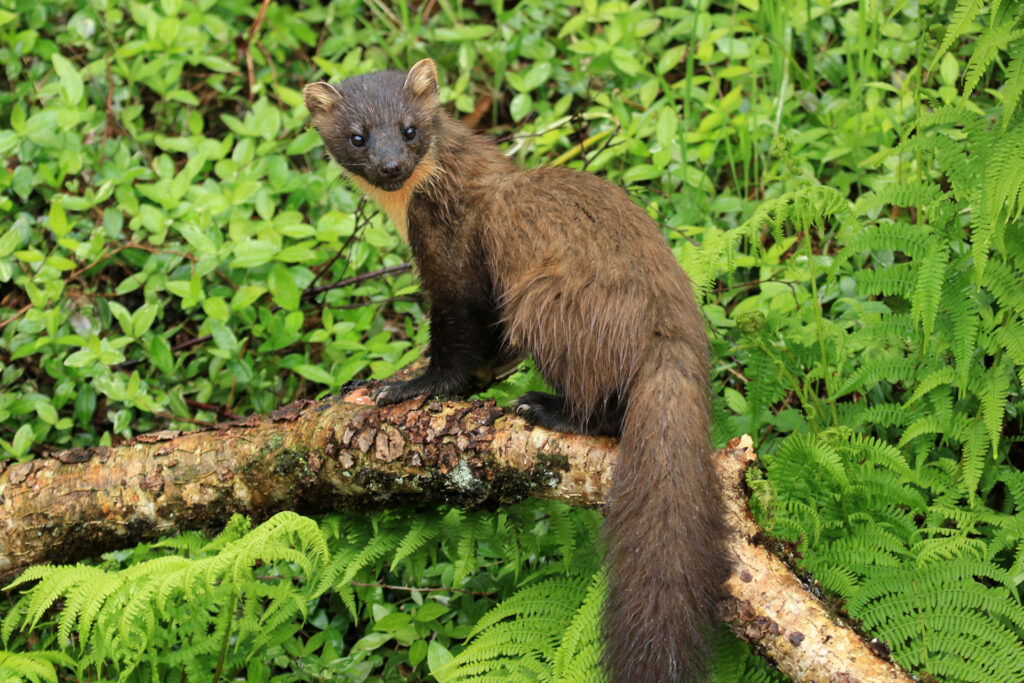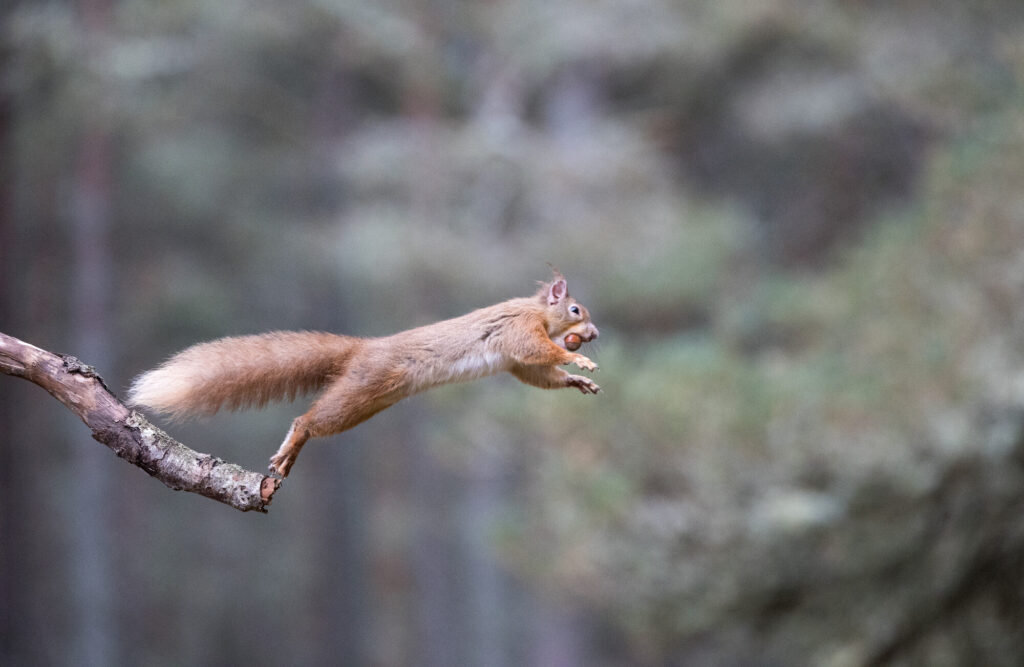Rewilding Europe’s European Wildlife Comeback Fund has supported the release of 13 pine martens in northwest England, helping to advance the recovery of this ecologically important animal in the UK. The fund has disbursed around 540,000 euros in support of 12 wildlife releases so far this year, with more grants in the pipeline.

Mic Mayhew / University of Cumbria
Accelerating pine marten recovery
A 50,000-euro grant from Rewilding Europe’s European Wildlife Comeback Fund has supported the release of 13 pine martens in the UK’s Lake District region, which is located in Cumbria in northwest England. The eight females and five males, which were reintroduced in Grizedale Forest and the Rusland Valley, were translocated from established pine marten populations in Scotland. The ecologically important animals, which are related to other mustelids such as badgers and otters, will help to strengthen food webs and enhance the overall health of local ecosystems.
Pine martens were common in Cumbria until the late nineteenth century, but then became locally extinct due to deliberate eradication and habitat loss. In 2022, a pine marten was caught on camera trap in southern Cumbria, indicating that the species is slowly recolonising the landscape. The aim of the South Cumbria Pine Marten Recovery Project, which is overseen by the University of Cumbria, is to accelerate the recovery of the species in the area, which would otherwise take many decades. The European Wildlife Comeback Fund grant will also support a second release of pine martens in 2025, with a total of around 30 animals set to be translocated through the initiative.
“The forests of south Cumbria provide perfect habitats for pine martens,” says Ian Convery, Professor of Environment & Society at the University of Cumbria’s Institute of Science & Environment. “Our aim is to establish a viable population and give the species a brighter future in the area. These animals should be in the landscape and are an important part of the local ecology.”

Mic Mayhew / University of Cumbria
Red squirrel boost
In Cumbria the released pine martens will share the landscape with other reintroduced species, such as red kites and beavers. As numbers increase, researchers believe their presence will benefit the local population of another native species – the red squirrel – which is currently declining.
Pine martens are one of the few animals agile enough to catch squirrels. While they prey on both native red and non-native grey squirrels in the UK, they predominantly target the latter. Grey squirrels, which were introduced into the UK from North America in the nineteenth century and are spreading northward in the UK, not only outcompete red squirrels for food, but also carry the squirrel pox virus, which is harmless to them but fatal to red squirrels.

Daniel Allen
Keeping track
The released pine martens will be monitored by academic and veterinary staff, volunteers, and students from the University of Cumbria, using radio-tracking techniques and remote camera traps to check on their health and keep track of their behaviour. A network of den boxes has been installed throughout the region to provide secure breeding sites for the pine martens next spring.

Mic Mayhew / University of Cumbria
Stakeholder collaboration
Feasibility work started on pine marten releases in south Cumbria in 2020. The reintroduction team has built strong relationships with the rural communities in the release area, who are enthusiastic about the return of the species. They are also working closely with local gamekeepers and farmers and will help to mitigate any coexistence challenges that may arise moving forwards.
The reintroduction initiative is also supported by a strong regional partnership. This includes the Upper Duddon Landscape Recovery Project, Natural England Local Area Team, Cumbria Wildlife Trust, and the Lake District National Park Authority, as well as Forestry England and the Graythwaite Estate, which adjoins the forest where the pine martens have been released.
An ecologically important animal
Pine martens have long, lithe bodies with chocolate-brown fur and a pale-yellow patch around their throat. Similar in size to a small domestic cat, they measure between 60 and 70 cm and weigh up to 2 kg.
Pine martens are mainly nocturnal, hunting from dusk to dawn. As omnivorous mesopredators, they play an important role maintaining the health of woodland ecosystems. They feed on what is seasonally abundant – including small mammals, insects, fungi, berries, small birds, eggs, and carrion – and are equally at home in broadleaf woodland and coniferous forest.
Once driven to near extinction by hunting, habitat loss, and predator control, pine martens now have a more hopeful future in the UK. While they remain one of Britain’s rarest mammals, populations are slowly recovering in Scotland and Ireland, and they are currently spreading into parts of England. They are also being reintroduced in a growing number of locations.
Scaling up European rewilding
The European Wildlife Comeback Fund works to scale up keystone species reintroduction and population reinforcement across Europe, with an agile setup designed to support wildlife comeback in a convenient and flexible way. Thriving wildlife populations play a critical role in ensuring the health and functionality of nature – while many European wildlife species are making a comeback of their own accord, others require a helping hand in order to become re-established. From January to November the fund has disbursed a total of 540,000 euros in support of 12 wildlife releases, with more grants set to be approved before the end of the year.
“This has been a really impactful year for the fund,” says Sophie Monsarrat, Rewilding Europe’s Rewilding Manager. “We have supported a wide range of releases, including freshwater fish (sturgeon and trout) for the first time, which illustrates the expanding scope of our efforts. I’m looking forward to continued success in 2025.”
“The grant was easy to apply for and the funding has made a big difference,” says Ian Convery. “The association with Rewilding Europe is very positive for us and has given us an opportunity to interact with other rewilding initiatives and experts. From a university perspective, it’s brilliant that the funding has helped to support the project because we can use it to give students real conservation experience.”
Rewilding Europe invites other initiatives working to reintroduce keystone species in European landscapes to consider applying for a grant. Those interested in contributing to wildlife recovery in Europe can support wildlife comeback with an online donation. If you’d like to invest more than 50,000 euros in the European Wildlife Comeback Fund, we’d love to get in touch with you personally.

Sophie Monsarrat

